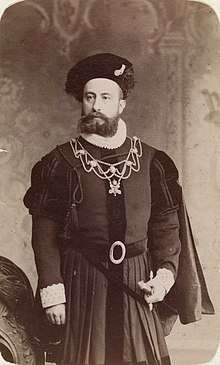Papal chamberlain
Papal chamberlain was prior to 1968 a court title given by the Pope to high-ranking clergy as well as laypersons, usually members of prominent Italian noble families. They were members of the Papal Court and it was one of the highest honours that could be bestowed on a Catholic layman by the Pope. Known as Chamberlain of the Sword and Cape (Cameriere Segreti di spada e cappa) when conferred upon laypersons, it was mostly an honorary position, but a chamberlain generally served the Pope for at least one week per year during official liturgical or state ceremonies. The office was abolished by Pope Paul VI and replaced with the designation Gentleman of His Holiness for laypersons and other designations for clergy.

Many came from families that had long served the Papal Court over the course of several centuries, while others were appointed as a high honor, one of the highest the Papacy conferred on Catholic laymen (often prominent politicians or wealthy philanthropists). They were originally selected from members of Italian royal and aristocratic families. The position was much coveted, and for priests, it was often the final step before becoming a cardinal.
From the days of Pope Leo I (440-461) the pontifical household had included papal chamberlains who were personal attendants on the Pope in his private apartments. The number of papal chamberlains was never large, although their proximity to the Pope meant that many chamberlains would enjoy notable ecclesiastical careers and some were even promoted to the episcopacy. Their privileges were considerable. They ranked ex officio as Knights of the Golden Spur (Order of the Golden Militia) and nobles of Rome and Avignon. Prior to Vatican II they provided personal assistance to the Pope on formal state occasions as members of the Papal Court. The dignity was often given to members of noble families of Italy and other countries. They were required, or in practice entitled, to serve for at least one week per year during official ceremonies, and took part in Papal processions behind the Sedia Gestatoria, each wearing formal court dress and distinguished by a golden chain of office. Traditionally, priests who were Papal Chamberlains were addressed as "Very Reverend". This clerical rank has been superseded by the current designation "Chaplain of His Holiness" which confers the title reverend monsignor.
In ecclesiastical heraldry, laypersons so honored may display a golden chain surrounding their coat of arms.
All appointments were announced in the Acta Apostolicae Sedis.
Grand Chamberlains
O'Conor Don, Roscommon, Ireland 1860.[1]
References
- Herbermann, Charles, ed. (1913). . Catholic Encyclopedia. New York: Robert Appleton Company.
- Irish Times, 1860
